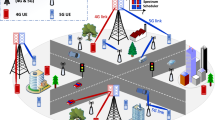Abstract
Long term evolution is standardized by the 3rd Generation Partnership Project to provide a high data rate up to 100 and 50 Mbps for downlink and uplink transmission respectively and can operate in different bandwidths ranging from 1.4 up to 20 MHz. Downlink LTE system is based on the OFDMA technique and uses several enhanced techniques in order to increase the spectral efficiency and aggregate the cell throughput. The incorporated scheduling mechanisms can significantly contribute to this goal. Scheduling mechanism is the process of allocated the resources (time and frequency) to users transmitting different flows in same time. In this paper, we propose a novel scheduling algorithm for downlink transmission in LTE system. The performances of the newly scheduler are simulated and compare to the performances of three basic scheduler such as Round Robin, Proportional Fair and Max Rate.







Similar content being viewed by others
References
3rd Generation Partnership Project, 3GPP TS 36.212- Technical Specification Group Radio Access Network. Evolved Universal Terrestrial Radio Access (E-UTRA): Multiplexing and channel coding (Release 08), November 2007. http://www.3gpp.org/.
Mehlführer, C., Wrulich, M., Colom Ikuno, J., Bosanska, D., & Rup, M. (2009). Simulating the long term evolution physical layer. In Proceedings of the EUSIPCO 2009 (pp. 1471–1478).
Ammar, M., Nsiri, B., Hakimi, W., & Eljamai, M. (2014). A comprehensive study of open-loop spatial multiplexing and transmit diversity for downlink LTE. International Journal of Computer Sciences and Telecommunication (IJCST), 5(2), 1–7.
Chen, Z., Wu, J, (2014). LTE physical layer implementation based on GPP multi-core parallel processing and USRP platform. In 9th International Conference on Communications and Networking in China (CHINACOM) (pp. 197–201), Maoming, China, August 14–16, 2014. http://ieeexplore.ieee.org/xpl/articleDetails.jsp?tp=&arnumber=7054285queryText%3DLTE+Physical+layer+procedures.
Capozzi, F., & Piro, G. (2012). Downlink packet scheduling in LTE cellular networks: Key design issues and a survey. IEEE Communications Surveys & Tutorials, 15(2), 678–700.
Louie R. H. Y., McKay M. R., & Collings I. B. (2011) Open-loop spatial multiplexing and diversity communications in ad hoc networks, IEEE Transactions on Information Theory, 57(1), 317–344.
Chadchan, S. M. (2013). A fair downlink scheduling algorithm for 3GPP LTE networks. International Journal of Computer Network and Information Security, 6, 34–41.
Bujalance, R., Gómez, G., Morales-Jiménez, D., Blánquez-Casado, F., Entrambasaguas, J. T. (2010). Performance evaluation of cross-layer scheduling algorithms over MIMO-OFDM. In Fifth International Conference on Broadband and Biomedical Communications (IB2Com) (pp. 1–5). Malaga, December 15–17, 2010. http://ieeexplore.ieee.org/xpl/articleDetails.jsp?tp=&arnumber=5723626&queryText%3DEvaluation+of+multiuser+scheduling+algorithm+in+OFDM+for+different+services.
Viswanath, P., Tse, D., & Laroia, R. (2002). Opportunistic beam-forming using dumb antennas. IEEE Transactions on Information Theory, 48(6), 1277–1294.
Assaad, M., & Mourad, A. (2008). New frequency-time scheduling algorithms for 3GPP/LTE-like OFDMA air interface in the downlink. In IEEE vehicular technology conference (VTC 2008) (pp. 1964–1969).
Seo, H., & Lee, B. G. (2004). A proportional fair power allocation scheme for fair and efficient multiuser OFDM systems. In IEEE global telecommunications conference (IEEE GLOBECOM ‘04) (Vol. 6, pp. 3737–3741).
Hahne, E.L. (1991) Round-robin scheduling and window flow control for max-min fairness in data networks, IEEE Journal on Selected Areas in Communications, 9(7), 1024–1039.
Tuan, L. T., Yoo, D., Kim, H., Jin, G., Jang, B., & Ro, S. H. (2012). The modified proportional fair packet scheduling algorithm for multimedia traffic in LTE system. In 6th international conference (ICHIT 2012) (pp. 122–129), Daejeon, Korea, August 23–25.
Conflict of interest
The authors declare that there is no conflict of interests regarding the publication of this paper.
Author information
Authors and Affiliations
Corresponding author
Rights and permissions
About this article
Cite this article
Nsiri, B., Mallouki, N., Mhatli, S. et al. Modeling and Performance Evaluation of Novel Scheduling Algorithm for Downlink LTE Cellular Network. Wireless Pers Commun 83, 2303–2316 (2015). https://doi.org/10.1007/s11277-015-2522-z
Published:
Issue Date:
DOI: https://doi.org/10.1007/s11277-015-2522-z




